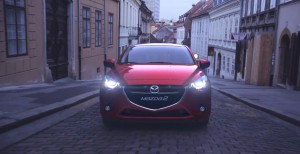Nearly two years after the maker had originally hoped to begin offering a diesel version of its SkyActiv engine system in the U.S., Mazda Motor Co. is getting close to making a final go/no-go decision, senior executives said during a luncheon meeting in Detroit.
In the wake of the Volkswagen diesel emissions scandal, Mazda planners are concerned about future demand for the high-mileage technology. Ironically, a Japanese version of Mazda’s SkyActiv-D powertrain has proven far more successful than expected, diesels now accounting for more than 70% of the maker’s home market sales.
The question is whether the emissions scandal has damaged the German maker’s image or diesel’s image, said Robert Davis, Senior Vice President of U.S. Operations for Mazda North America. “We think the damage is to Volkswagen, but we’re still deciding” whether there’s enough demand for Mazda to finally launch a U.S. diesel.
(Mazda CX-9 a contender for North American Utility Vehicle of the Year. Click Here for more.)
Mazda had originally slated the SkyActiv-D launch for the beginning of the 2014 model-year, then pushed it back to the spring of that year before putting it on indefinite hold.
The initial reason for the delay was technical, company officials said. The challenge was to come up with solid performance while meeting tough new NOx and particulate emissions rules – all the while delivering the sort of fuel economy diesel buyers would expect.

While Mazda has yet to sell a U.S. diesel, it did score well with a racing version of the Skyactiv-D.
The engineering challenge was all the more frustrating because VW had been able to find that solution – at least, so it seemed until it was revealed by the U.S. Environmental Protection Agency last September that the German carmaker had used a so-called “defeat device” to rig its emissions tests.
U.S. diesel sales have taken a sharp hit since the subterfuge was discovered, though much of the decline reflects the fact that Volkswagen was the largest marketer of “oil-burners” in the American market, with its 2.0- and 3.0-liter turbodiesels accounting for about a quarter of its total sales.
(Mazda3 lands spot on Best Family Car list. Click Here for the story.)
Nevertheless, some senior executives are skeptical whether demand will rebound.
“If you like at industry data, you see little opportunity to be successful with diesel engines in the U.S.,” said Masahiro Moro, the CEO of Mazda North American Operations.
That said, the same might have been the reading of the Japanese market until recently. Diesels have traditionally accounted for barely 1% of that country’s passenger vehicle sales, but the figure has nearly doubled since Mazda launched a home market version of the SkyActive-D.
That 1.5-liter powertrain is used across the line-up, from the little Mazda2 to larger products like the Mazda6, as well as various crossovers. And on some products, it now accounts for more than 80% of demand. Overall, diesels power 70% of the vehicles Mazda is now selling in Japan, noted Moro. And the Hiroshima-based maker accounts for about 50% of total Japanese diesel volume which has nearly doubled since the launch of the SkyActiv-D.
(Not all gasoline blends are up to snuff, warns AAA. Click Here to learn why.)


As a VW diesel owner, I would welcome the opportunity to buy a Mazda diesel. I doubt VW will be offering diesel again in the US market. That leaves thousands of car buyers looking to buy a fun to drive diesel vehicle. Mazda is the perfect car company to fill this demand.
I’ve only driven a Mazda 6 this year as a rental (but had an MPV for 10 years until 2015). But if they had offered it in a diesel I would have bought one when I finally got tired of waiting for somebody, anybody, to bring on a decent-sized replacement for my last MB and. Chevrolet didn’t have a stick, the back seat was tight, MB didn’t even have one, then VW brought on their “US only” bigger cars.
Now one of them, a non-urea Jetta will go away, I’m sure. Mazda, this is your chance!! ?
Mazda like Toyota and Honda ARE not bringing a diesel to the USA… emission problems, so they say.
So far, it all has be hype to getting their names into the news.
Too Bad! The USA sure could use one.
two VW Diesels on lease.. would buy/lease Mazda Diesels next but not gasoline models.. Diesels are awesome for driving long distances… and a reason to buy a Mazda.
Americans generally have short memories. In a year the diesel scandal wold be all forgotten. A mazda 2 sedan diesel might do well. Even w low gas prices im always searching for goo fuel economy. Never when these prices were surge again.
Plus Mazda needs to raise its CAFE a diesel should help.